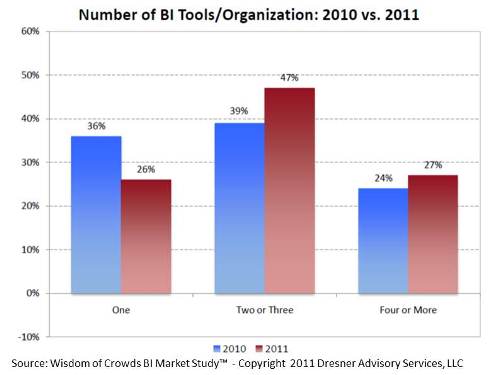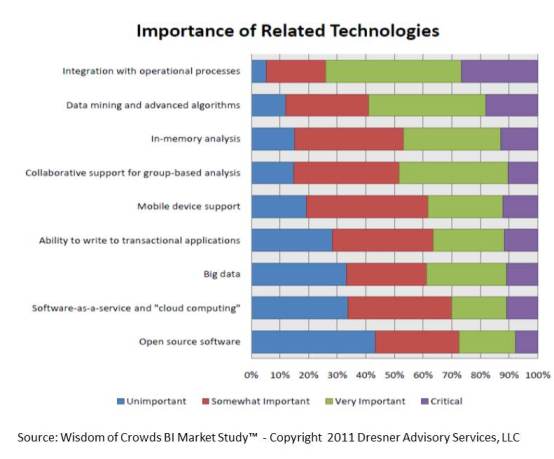Business intelligence is expanding and facing new approaches and technologies, offering both opportunities and disruptions for suppliers and buyers, according to the findings in our 2011 “Wisdom of Crowds Business Intelligence Market Study.” A new era is unfolding in business intelligence, characterized by a broader customer base than a few years ago and a more mainstream understanding of BI’s value. Our study found that initial implementations are expanding, as are the numbers of tools. However, organizations must establish greater governance and also elevate BI to a strategic level to ensure optimal benefits from their BI investments.
Our second annual business intelligence market study revealed several aspects in the way the market is evolving in just the past year. Some of these aspects include:
- The number of new business intelligence deployments slowed in 2011 compared to 2010, but existing deployments expanded.
- Sixty-three percent of respondents increased their BI budget in at least one area, and 31 percent increased budgets more than 10 percent in at least one area.
- Solutions from open source and emerging vendors had the largest percentage of adoption in the last two years (as opposed to titans and established pure-play vendors).
- There is a strong demand, and increased spending, for consulting services related to BI. Having spoken with vendors, we attribute this demand primarily to smaller deployments growing into larger, more complex deployments.
- The size of the organizational BI workgroup is larger in 2011 than in 2010 and appears to be settling at between six to 50 users.
Here are some of my observations and recommendations for buyers of BI solutions.
1. Users are in the driver’s seat and often sidestep IT
BI customers are now demanding solutions that are easier to buy, deploy, integrate and use; support mobile computing; and support in-memory and collaborative/social capabilities.
Our study – which surveyed 630 small, medium, large, and very large organizations in multiple industries in North America, EMEA, APAC and LATAM – found that that the growing trend of shifting over the past five years to business management and users instead of IT in business intelligence deployments continues. In fact, more than half of BI deployments are now more closely aligned with business users than IT.
The trend by end users to do their own thing is accelerating. Up to now, it was mostly evident in North America, but we’re now starting to see it in EMEA as well.
Recommendations: The trend of end users sidestepping IT is not a fad. IT departments need to get aligned with the business end users today – don’t wait. First, the IT Department should begin to use business Intelligence to manage the business of IT. Next, IT should become more fluent in the issues facing business. Start by reading business publications to develop a broader understanding and perspective of the business. Next, cultivate relationships with business counterparts. Perhaps set up a BI discussion group, jointly chaired by users.
2. BI tools proliferation
I believe this trend of end users being in the driver’s seat accounts for the fact that the proliferation of overlapping BI tools continues to grow (especially in the largest organizations). Organizations using commercial open source BI are less likely to have multiple BI tools.

As budgets shift away from IT and toward end-user departments, these numbers will continue to rise. Many vendors cater to users and departmental functions and make it easy to sidestep IT. Vendors basically say: “Forget IT; just buy our tool.”
Users often are unaware of all the BI tools used in their organization and adopt BI tools without the benefit of corporate standards. I’m excited about a lot of people wanting to use facts to inform their decision making. But from my experience, this proliferation of tools will result in the age-old problem of multiple and conflicting answers to business questions. Ask five people the same question, and you’ll get five answers that disagree with each other. And that’s a problem.
Recommendation: It’s okay for users to drive technology adoption, but organizations must address standardization and governance.
3. Technologies strategically related to BI implementations
Our study asked respondents to rank nine technologies and initiatives as to their strategic importance in their organizations’ business intelligence efforts. As illustrated in the chart below, they ranked “integration with operational processes,” “data mining and advanced algorithms,” and “in-memory analysis” as most important in their BI efforts.
 Deeper analysis of their responses revealed that:
Deeper analysis of their responses revealed that:
- Users of products from commercial open source or established pure-play BI vendors are more likely to view “in-memory analysis” as “critical” or “important.” This feature is especially more important to users in finance functions.
- Although Big Data technologies ranked low overall (#7 out of nine technologies assessed), they are of greater interest in organizations with 10,000 or more employees. Midsized companies have the least interest in Big Data.
- Big Data has greater interest in organizations in Asia and Latin America than in other regions. We believe this phenomenon may be a reflection of the close alignment of Big Data with open source technologies such as Hadoop and MapReduce, which have high acceptance outside of North America.
- Cloud and Software-as-a-Service (SaaS) ranked low (#8 of nine technologies) in importance as technologies or initiatives related to BI; this is especially true in larger organizations. However, smaller organizations are interested in cloud and SaaS in relation to BI, most likely because of the anticipated cost savings and rapid implementation.
Recommendation: Even with less mainstream technologies, it’s typical to find important niche areas that perceive (or receive) great value. The question is whether this value of these technologies can be generalized and become the norm.
4. Data mining and the buzz around predictive analytics
Sixty percent of the respondents in our study stated that data mining and advanced algorithms are “critical” or “very important” to their organization. However, it’s important to first master the descriptive statistics before dipping into the predictive and inferential statistics waters. This is because most organizations still have not done a good job in understanding “what” has happened and “why” before trying to determine what might happen next. Having good understanding of the past is essential to developing a credible view of the future.
Although vendors like to talk about predictive analytics, it’s actually centuries old. Having said that, buyers need to know what predictive analytics are and what they aren’t. Bottom line: predictions are not facts. I caution people to put predictive analytics in the perspective of a pilot in an airplane. The cockpit has great instrumentation on the instrument panel in the cockpit. But every so often, it’s a good idea that the pilot look out the window.
Recommendation: Develop scenarios and prepare for the proverbial “black swan effect.” There are areas where data mining, inferential statistics and predictive analytics can’t help, and there are things that one can’t predict. Even in very stable companies with a lot of historical data, unpredictable things emerge. But one can develop scenarios and prepare.
5. Collaboration
Nearly half of our study respondents (48 percent) ranked collaboration in business intelligence as “critical” or “very important.” Key characteristics of collaboration include:
- Annotating, sharing, discussing
- Information or workflow
- Synchronous vs. asynchronous
- Bi-centric or external framework
I’m a big fan of collaborative technology and using it with business intelligence. Most of the world uses email as their collaborative tool. That’s fine, but everything imaginable shows up in an email inbox and causes different levels of abstraction. This is because users have to apply context. But with collaborative technology, the item is already in the context of a specific project or a specific insight.
Recommendation: Achieving collaboration starts with building and sustaining a collaborative culture. If employees aren’t motivated to share information, then the best technology won’t help.
6. Organizations need to improve the way they operationalize BI
In our study most respondents reported that their organizations want to do a better job of leveraging their existing business intelligence solutions within operations to improve execution. In fact, 75 percent stated that operationalizing BI is “critical” or “very important.”
Operational business intelligence – as part of a broader BI strategy – has a groundswell of support and may be a good investment. There are several approaches to operationalizing BI:
- Reports, dashboards, etc. against operational data
- Event processing (e.g., CEP)
- Embedding in operational process (e.g., BPM)
CEP (complex event processing) takes real-time streams of data and analyzes them using pre-defined rules, then generates and directs alerts to users. Integration with operational processes can be used to provide insight – in context to a particular activity (e.g., call center). This provides the user with perspective relevant to that immediate activity or process.
Recommendation: Organizations should undertake operationalizing a business intelligence solution as part of a broader “management system” initiative. A retail customer shared with me that, using operational BI, they were able to identify reduced sales for one SKU, in one store, on a single day. Upon investigation, the manager realized that the related product display was obscured. In isolation, this isn’t a huge issue. However, when multiplied across all stores, all SKUs and throughout the year, it has a tremendous impact upon revenues.
Mobile technologies are creating a business intelligence renaissance
In business intelligence and the consumerization of IT, the iPad is the number-one item out there, and it dwarfs everything else. There are iPads everywhere now, especially with executives. All of a sudden, execs are getting dashboards on their iPads, and they’re looking at the data. This has literally caused a revolution in business intelligence.
Seventy percent of the respondents in our survey indicated that 25 percent of their BI users are mobile. Another 23 percent stated that 50 percent of their users are mobile.
Executives connected to their company’s business intelligence data anytime, anywhere, can actually correct problems before they get out of hand.
However, as with any other technology, organizations should make certain there is a clear need, strong cultural acceptance and an understanding of the pros, cons and value potential before adopting any new business intelligence or mobile solution.
To download the entire study report (including rankings of BI vendors, market segmentation by industry, and much more), visit www.businessintelligenceinsider.com and become a member.
The Wisdom of Crowds Business Intelligence Market Study™ was conceived and executed by Dresner Advisory Services, LLC, an independent advisory firm, and Howard Dresner, its president, founder and chief research officer. Howard Dresner is one of the foremost thought leaders in Business Intelligence and Performance Management, having coined the term “Business Intelligence” in 1989. He has published two books on the subject, “The Performance Management Revolution – Business Results through Insight and Action,” and “Profiles in Performance – Business Intelligence Journeys and the Roadmap for Change.” Prior to Dresner Advisory Services, Howard served as chief strategy officer at Hyperion Solutions and was a research fellow at Gartner, where he led its Business Intelligence research practice for 13 years.
